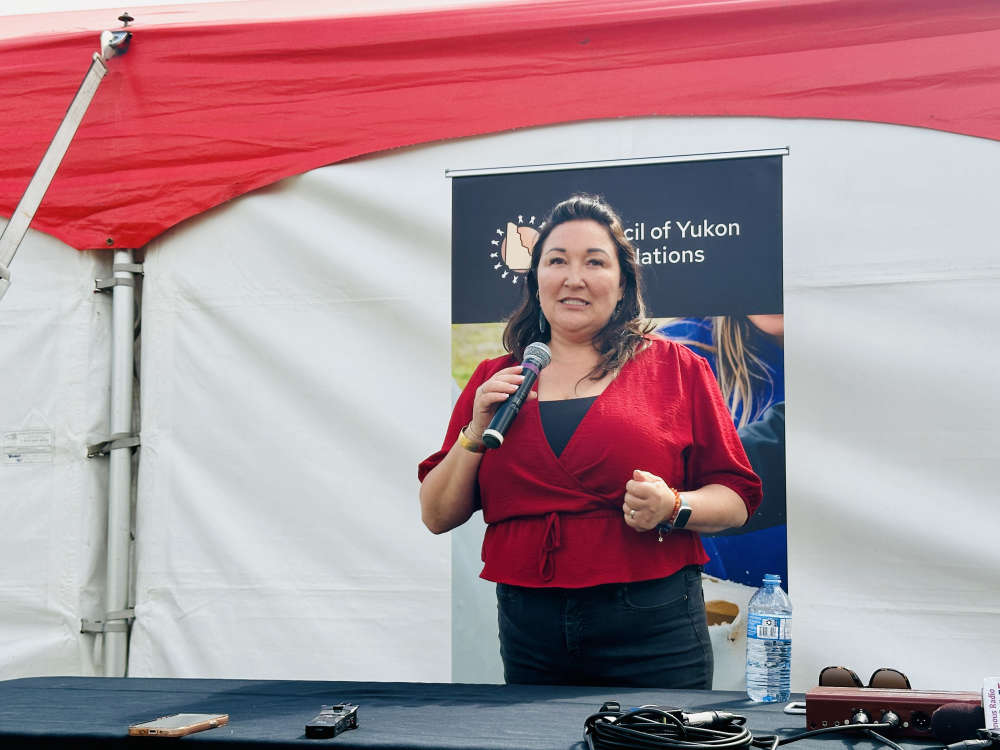
Yukon Energy Corporation and Champagne Aishihik are at odds about the current application to be considered for the water license application needed to operate the hydroelectric dam.
Overview
This week, tensions grew as two factions sit on opposite sides of the lake.
In 1975 the Aishihik Generating Facility began operation to support yukon's growing energy needs with a renewable source.
Since then, Yukon has come to rely on the powerhouse of the corporations capacity, up to 50% in winter.
As the relicensing for the water from the Aishihik lake deadline approaches, there are fundamental differences that have caused a separation in joint protocol agreement.
Champagne Aishihik First Nation
Deputy Chief of Champagne Aishihik First Nation (CAFN), Rose Kushniruk gave a briefing at Council of Yukon First Nation (CYFN) boardroom about the stance her first nation is taking on the Aishihik Hydro Facility.
In a letter sent to Yukon Energy Corporation (YEC) President Andrew Hall in October, CAFN urged YEC to reconsider its decision to abandon the Protocol Agreement, from 2016. In doing so they have extended an opportunity to get the collaborative relationship back on track.
The director of Heritage lands and resources for CAFN, Roger Brown believes there is an alternative to the status quo.

Chief of Champagne Aishihik FN, Dan natthe ada Kaaxnox, Steve Smith has said of the hydro electric project “The story of the Aishihik dam is one of hardship with a legacy of past wrongs and ongoing negative impacts.” He continued "We have an opportunity to address these Impacts and work together toward a better future. We believe recognition of our rights and the value of our relationship to the land are essential."
Indian Affairs at one point moved the village of Asheyi to Haines Junction in the 1960's in preparation to build the dam.
Though the Yukon Energy Corp and therefore the Yukon Taxpayer may suffer from costs of non-renewable fuel increases, Brown indicates it's the land and the first nations people whose traditional territory the dam is on that take the bulk of the burden.
Brown said, "People of Aishihik have been in a sense subsidizing cheap energy for decades because of the kinds of impacts that they have received, yet no meaningful benefits or any real payback and recognition for the kinds of costs that Aishihik people and the land and the water have beared because of that."
The water level of the lake has created erosion, loss of homes and gravesites, while the dam powers up to 37% of the Territories energy.

Yukon Energy
Yukon Energy Corporation held a public hearing about the Aishihik Hydro Facility at the Canada Games Centre on Tuesday.
Regarding key elements of their project proposal to Yukon Environment and Socio-Economic Assessment Board (YESAB), Yukon Energy highlight their responsibility to provide sustainable, cost-effective and reliable electricity to Yukoners.
They laid out their approach, including how they worked with the CAFN, creating a steering committee and preparing a joint protocol agreement.
One Elder member of the FN said the displays were 'full of lies'. She recalls a time when the village of Asheyi was right next to the water of fish spawning grounds. Currently it sits as a dry basin.
Travis Ritchie, Manager of Environment for YEC and part of the planning team points out healthy fish numbers, and only a few examples on the lake that are eroding but being mitigated.

Michael Brandt, Vice President with the corporation says they deal only in 'science and facts'.
The water license expires in 2019 and timeframe to have the water relicensing application pass through the YESAB is very tight.
Brandt says they have to move forward to avoid disruption of service and penalties."We can not operate without a license, and that's why we have to work to a schedule, and as it is we're already late, and there are high costs and risks associated with being this late so we have a lot to do."
The Aishihik Hydro Facility is the workhorse of Yukon Energy providing over 25% of the territories power, and as much as 50% being drawn during the winter months.
No viable alternatives are on the horizon, and the costs to Yukoners to return the water levels to pre-dam levels are in the $10 million/year range according to Yukon Energy Corporation.

Future Energy
As the corporation look to the future to provide capacity for growth, especially in the mining sector, almost no projects are getting the green light. Proposed in recent years are the Next Generation Hydro projects which hasn't gained momentum and the Southern Lakes enhancement project which proposes a change to the water license to increase the water stored in the southern lakes that feed the Whitehorse Hydroelectric facility. in the fall for use in the winter.
The remaining public engagement takes place Friday Dec 7th in Haines Junction at the St. Elias Convention Centre at noon until 2pm.



 Yukon RCMP leads the way in body-worn camera deployment
Yukon RCMP leads the way in body-worn camera deployment
 Math'ieya Alatini elected CYFN Grand Chief
Math'ieya Alatini elected CYFN Grand Chief
 Watson Lake man charged in firearm robbery
Watson Lake man charged in firearm robbery
 House fire in McIntyre contained
House fire in McIntyre contained
 RCMP plane crash caused by faulty sensor: TSB report
RCMP plane crash caused by faulty sensor: TSB report
 New Fireweed Mental Health unit opens at Whitehorse General Hospital
New Fireweed Mental Health unit opens at Whitehorse General Hospital
 Traditional learning camp opens at Whitehorse school
Traditional learning camp opens at Whitehorse school
 Yukon Schools introduce online registration for bus service
Yukon Schools introduce online registration for bus service
 Yukon Government unveils progress in healthcare transformation with 2024 Putting People First annual report
Yukon Government unveils progress in healthcare transformation with 2024 Putting People First annual report
 Whitehorse Emergency Shelter unveils New Artwork celebrating Yukon First Nations culture
Whitehorse Emergency Shelter unveils New Artwork celebrating Yukon First Nations culture
 Former Whitehorse City Councillor Ted Laking announces bid for Yukon Party nomination in Porter Creek Centre
Former Whitehorse City Councillor Ted Laking announces bid for Yukon Party nomination in Porter Creek Centre
 Yukon Government seeks applicants for new Health Authority Board
Yukon Government seeks applicants for new Health Authority Board
 Canada Post strike looms, Yukoners brace for disruption
Canada Post strike looms, Yukoners brace for disruption
 Driver charged in fatal collision that killed Yukon Government Deputy Minister and injured Minister
Driver charged in fatal collision that killed Yukon Government Deputy Minister and injured Minister
 Yukoners encouraged to apply for Northwestel's Northern Futures Scholarship Program
Yukoners encouraged to apply for Northwestel's Northern Futures Scholarship Program
 City of Whitehorse summer transportation maintenance work underway
City of Whitehorse summer transportation maintenance work underway
 Yukon Government seeks input on new downtown public school
Yukon Government seeks input on new downtown public school
 Indigenous leadership takes centre stage: Rebecca Chartrand and Mandy Gull-Masty appointed to key cabinet roles
Indigenous leadership takes centre stage: Rebecca Chartrand and Mandy Gull-Masty appointed to key cabinet roles
 Whitehorse prepares for Annual 20-Minute makeover
Whitehorse prepares for Annual 20-Minute makeover
 RCMP conducting training exercises on Schwatka Lake
RCMP conducting training exercises on Schwatka Lake